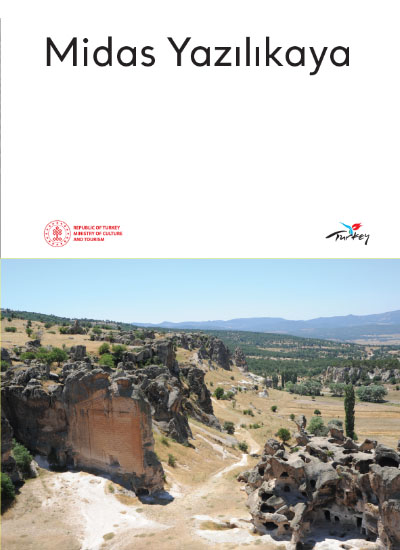The Midas Yazılıkaya Archaeological Site is situated at the southern end of Yazılıkaya Valley, to the west of Yazılıkaya Village in Han Town, Eskişehir. It is located on the tuff formation of Yazılıkaya Plateau, measuring 650 metres in length and 320 metres in width. The site is elevated approximately 60-70 metres from the valley floor. The Phrygians carved many monumental religious buildings into the rocks, giving the City of Midas a privileged position. Gordion was the most powerful political centre of the Phrygian state, while the City of Midas held the most important religious significance since the beginning of the kingdom. The city's first settlement dates back to the 3rd millennium BC, with the earliest Phrygian settlement established in the last quarter of the 8th century BC. Following the political collapse of the Phrygian Kingdom, the city remained inhabited and its rock structures were repurposed during the Persian, Hellenistic, Roman, and Byzantine periods. The city wall from the Phrygian period no longer exists. The primary entrance to the city is located in the east. The ramp leading to the bedrock is called the King's Road and features figurative reliefs carved into the rock masses. The city features several significant structures, including stepped altars carved out of the bedrock on the plateau, two rock tunnels with vaulted covers descending by rock stairs, and monumental rock cisterns on the lower terrace in the southwest direction. Additionally, there are numerous cult monuments on the high tuff rocks surrounding the settlement, which consist of stepped altars, niches, and chamber tombs. The Phrygians' deep respect and devotion to the Mother Goddess Matar Kubileya, who symbolises nature, is reflected in the religious monuments carved into the rocks in Midas City and Yazılıkaya Valley. These open-air temples are all dedicated to the cult of the Mother Goddess Matar Kubileya. The facades, with triangular pediments and roofs, represent the front facades of Phrygian dwellings. The façade decorations of triangular pediments are adorned with geometric and floral motifs, similar to those found in Phrygian woodwork. The central niche, which is the most important part of the façade, takes the form of a door with a statue or relief of a goddess. Niches are shallow cavities, usually oval or rectangular in shape, located on the steep faces of rocks at easily accessible heights. The back walls of the niches contain slots where a goddess statuette or idol is placed. Yazılıkaya-Midas City provides good examples of such niches. Altars are structures used for making prayers, sacrifices, and offerings to the gods. In front of them, steps lead to the round-headed, quadrangular-bodied idols of the goddess. The most beautiful examples of these altars can be found in Midas City. Yazılıkaya Midas City is a valuable cultural treasure of the Mountainous Phrygia Region, featuring unique monumental structures. It has been nominated for inclusion in the World Cultural and Natural Heritage list.
MİDAS YAZILIKAYA ARCHAEOLOGICAL SITE


